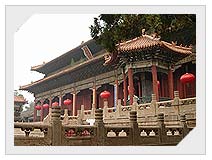 Most of the present attractions inside the temple were left over from the Han Dynasty. Seen from a distance, a feel of grandiosity and magnificence appears in your mind. Take a closer view and you will feel astonished by its stateliness. It is the symbol of the Chinese feudality. Standing at the entrance to the temple, Yaocan Pavilion and the Archway of the Dai Temple will appear before your eyes first. Its grand framework and elaborate engravings impress tourists deeply and entice them to visit the temple. Entering it, there are many gateways and palaces, colorful and brilliant. Among them, the most conspicuous is the Hall of Celestial Gifts built in 1009 AD.
Most of the present attractions inside the temple were left over from the Han Dynasty. Seen from a distance, a feel of grandiosity and magnificence appears in your mind. Take a closer view and you will feel astonished by its stateliness. It is the symbol of the Chinese feudality. Standing at the entrance to the temple, Yaocan Pavilion and the Archway of the Dai Temple will appear before your eyes first. Its grand framework and elaborate engravings impress tourists deeply and entice them to visit the temple. Entering it, there are many gateways and palaces, colorful and brilliant. Among them, the most conspicuous is the Hall of Celestial Gifts built in 1009 AD.
 Mount Tai is located in the middle of Shandong Province. It is not merely the mountain home of the Gods such as Mt. Olympus or Mt. Sinai; it is considered a deity itself and has been venerated by the Chinese as their most sacred peak. The emperors of ancient China regarded Tai Shan as the son of the Emperor of Heaven, from whom they received their own authority to rule the people. The mountain functioned as a God who looked after the affairs of humans and who also acted as a communication channel for humans to speak to God. Seventy-two legendary emperors are said to have come to Tai Shan, but the first known evidence dates from a rock carving left on the mountain in 219B.C.
Mount Tai is located in the middle of Shandong Province. It is not merely the mountain home of the Gods such as Mt. Olympus or Mt. Sinai; it is considered a deity itself and has been venerated by the Chinese as their most sacred peak. The emperors of ancient China regarded Tai Shan as the son of the Emperor of Heaven, from whom they received their own authority to rule the people. The mountain functioned as a God who looked after the affairs of humans and who also acted as a communication channel for humans to speak to God. Seventy-two legendary emperors are said to have come to Tai Shan, but the first known evidence dates from a rock carving left on the mountain in 219B.C.

